UNPACKING MEMORIES
An Interview with TUMI Creative Director Victor Sanz
by Felix Burrichter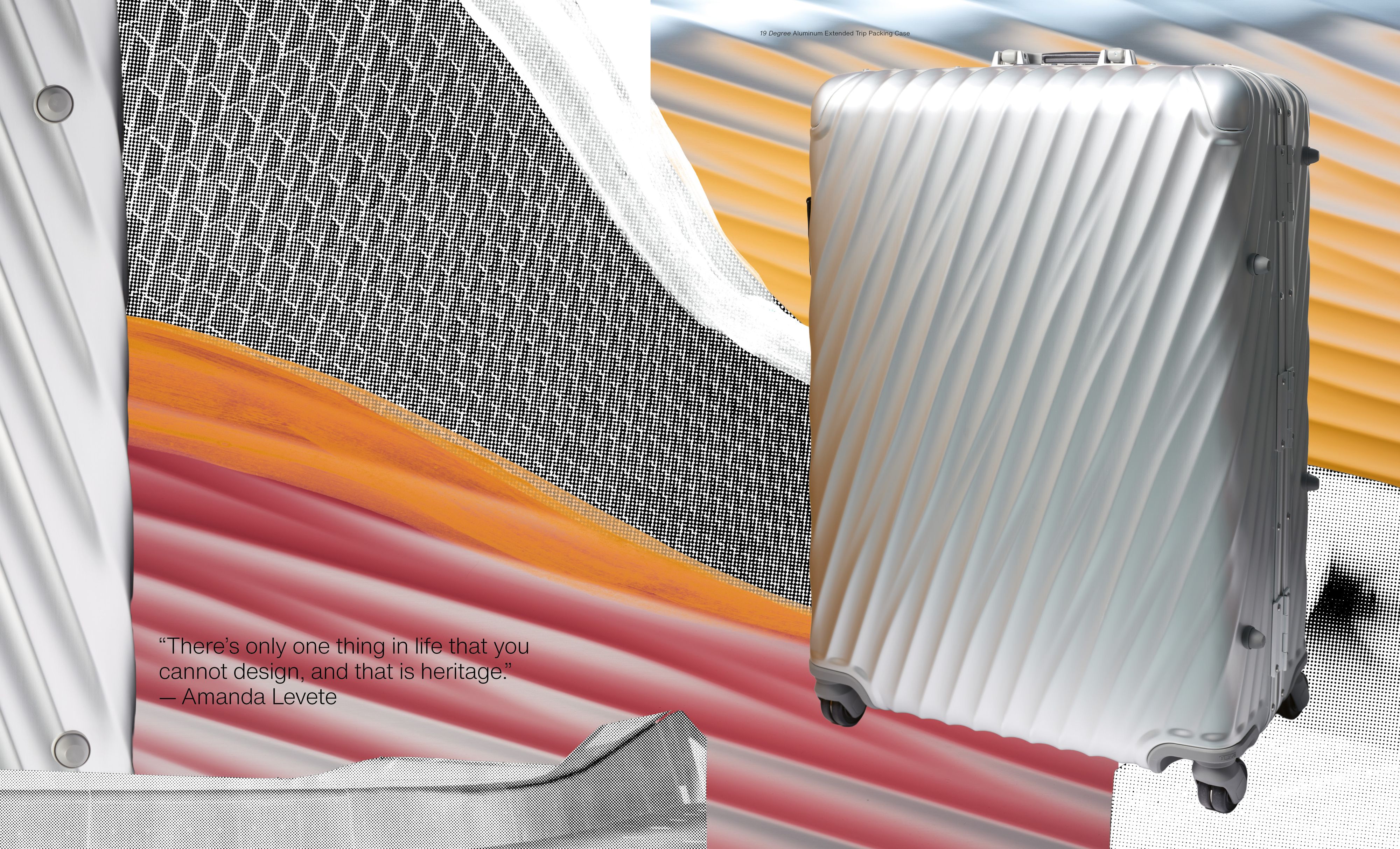
Collage featuring TUMI's 19 Degree Aluminum Extended Trip Packing Case. Photography and artwork by Luke Libera Moore for PIN–UP.
If we imbue objects with meaning, then our luggage is the ultimate box of memories. Holding more than clothes and stuff, it’s the repository of the journeys we’ve taken, the experiences we’ve had, and the stories we bring back. In a sea of industrial, rational-oriented luggage, TUMI has taken this deeper meaning to heart and carved out its own niche: designs where function meets sculpture and forms recall the movements of sand, water, or sky. Victor Sanz, who became TUMI’s Creative Director in 2016 after 22 years with the company, has been largely responsible for this shift. With a background in sculpture and a deep interest in architecture — particularly the parametric geometries and fluid forms of Zaha Hadid — Sanz has brought a spatial, almost architectural approach to TUMI’s product design. Under his vision, the brand has expanded beyond luggage into eyewear, fragrance, outerwear, and even audio gear, all guided by an ambition to address the full spectrum of their customers’ travel lives. As TUMI marks its 50th anniversary, Sanz reflects on nearly half that history from within — and on what he considers the pinnacle of his work there: the 19 Degree collection, a 21st-century design classic in its own right.
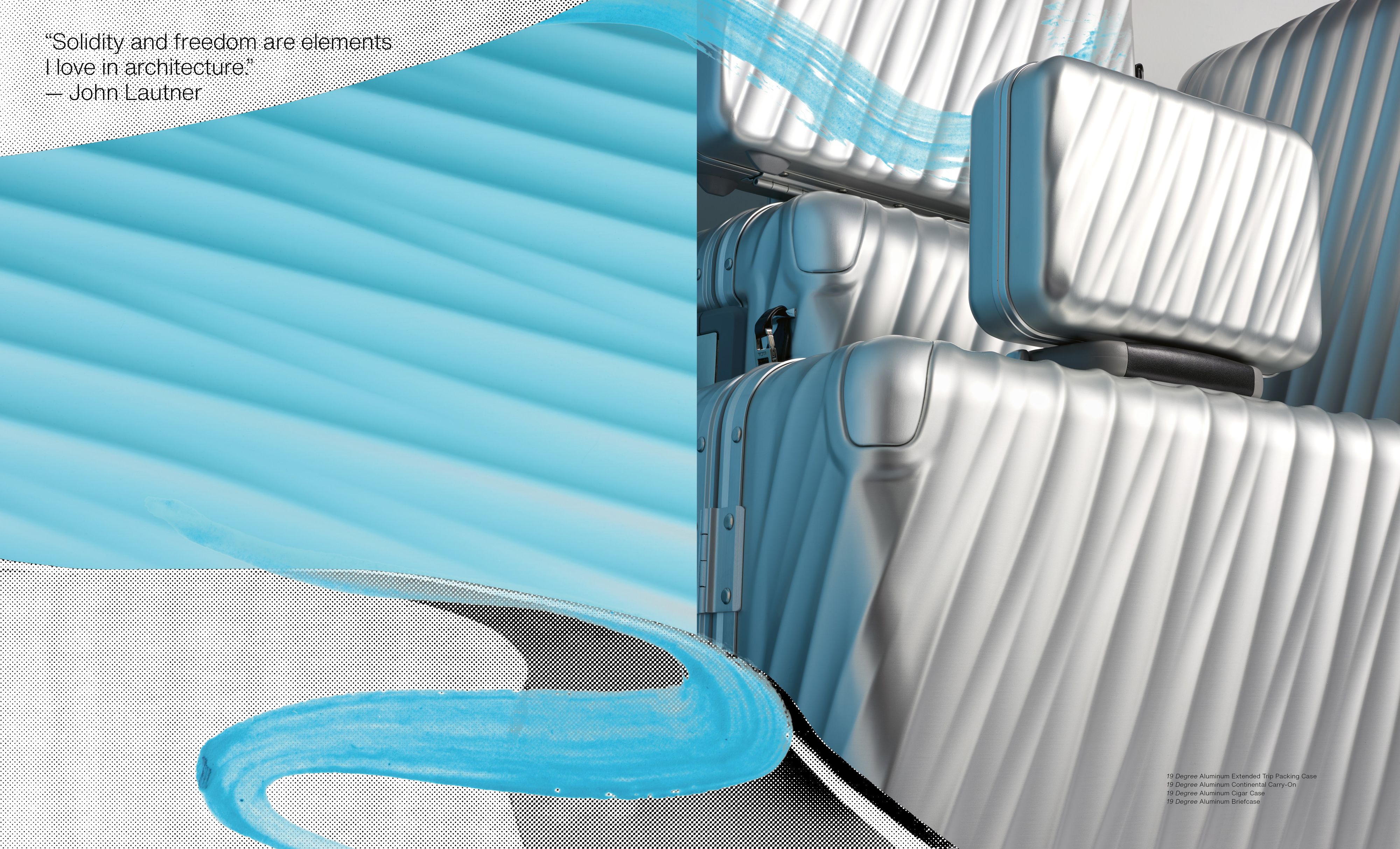
Collage featuring TUMI's 19 Degree Aluminum Extended Trip Packing Case, Continental Carry-On, Cigar Case, and Briefcase. Photography and artwork by Luke Libera Moore for PIN–UP.
Felix Burrichter: How did the 19 Degree pattern for TUMI develop?
Victor Sanz: When I started my career, I studied traditional arts — painting, drawing, sculpting. My dream was to be a sculptor. In high school, someone showed us a Luigi Colani bicycle. I thought, “What is this? It looks like a sculpture, but it's a bicycle.” That’s when I realized: here’s a discipline where I could sculpt, but the work reaches so many more people. The 19 Degree collection is the closest I’ve come to a functional sculpture. The original idea came during a seven-hour layover. My flight kept getting delayed, and I thought: why can't luggage be more like a sculpture, so I could sit and appreciate it?
What luggage were you using then?
TUMI’s Alpha, the quintessential road-warrior piece. It worked great, but I couldn't see art in it. When we developed the 19 Degree aluminum collection, we wanted a new design language — one celebrating fluidity, motion, and the intersection of art, design, and engineering. The ribs don't run edge to edge; they stop and start intentionally. Your eye travels across the surface, a vernacular closer to sculpture. I have one piece in my studio as furniture and one on my wall as art.
The 19 Degree pattern evokes movement — curves of waves or dunes. It reminds me of a bias cut dress.
Now that you say that I’m thinking we should design a clothing collection.
Where did the 19-degree angle come from?
It turned out to be the optimal angle. Visually it creates motion, but structurally it provides support for the entire surface and corners.
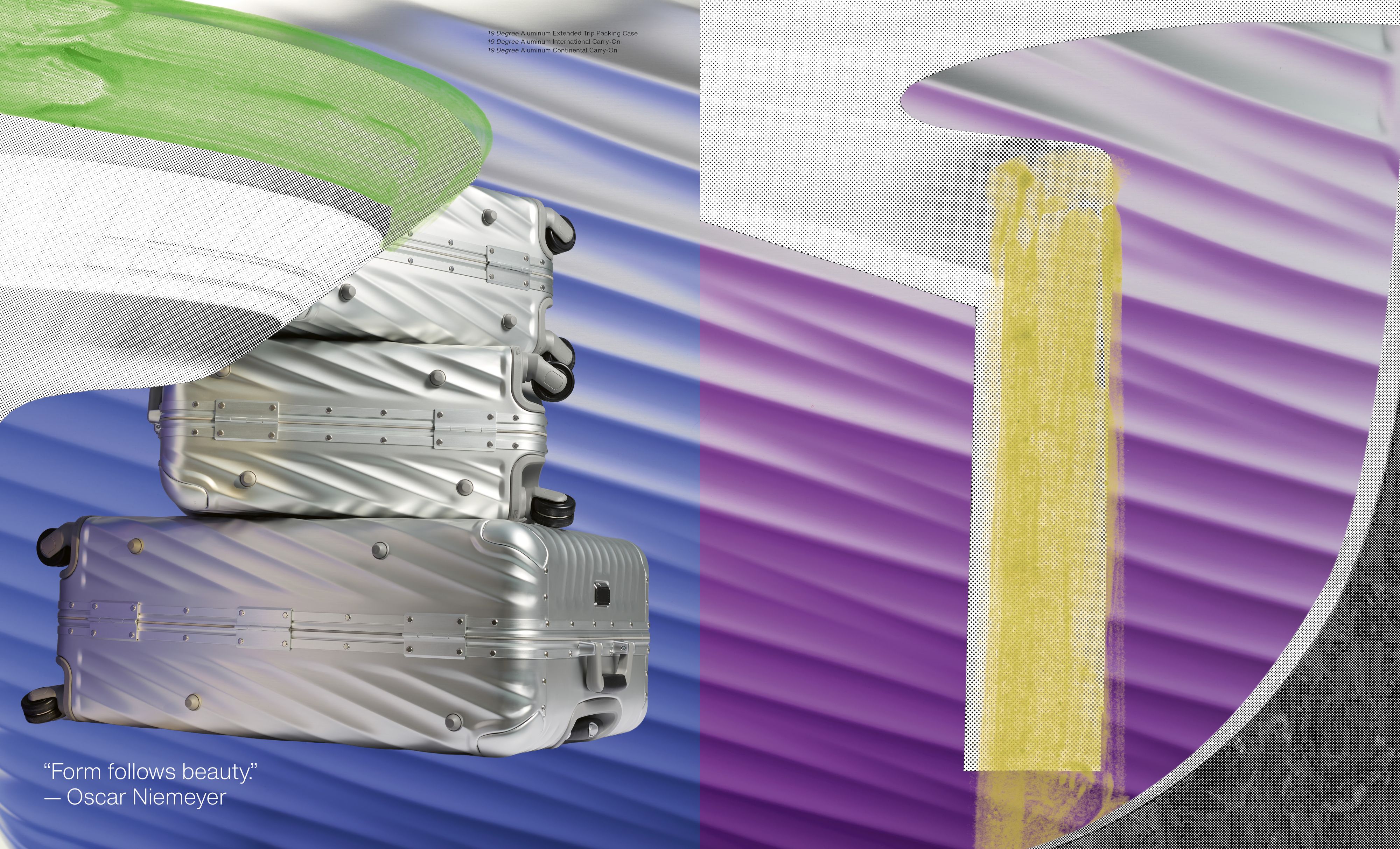
Collage featuring TUMI's 19 Degree Aluminum Extended Trip Packing Case, International Carry-On, and Continental Carry-On. Photography and artwork by Luke Libera Moore for PIN–UP.
Does that mean you can’t dent it?
t takes force to dent aluminum, but it’s still possible. I think you’re supposed to have some dents in your luggage. I remember exactly how I got the first scratch on the prototype — traveling in Seoul, someone dropped it on an escalator edge. I still travel with that prototype and can tell you where I got every scratch. It’s part of the memories you create.
What are some of your most memorable journeys with TUMI luggage?
I’m first-generation American, so I spent every summer in Spain with my parents and grandparents. That’s where my travel obsession began. My first time in Asia was unforgettable — at 22, three months out of university, I flew to Tokyo. It was before the Internet, and I felt like I’d landed in the future. Even 20 years later, that feeling returns every time.
The subconscious memory of a place always lingers: mental texture, scratches on a suitcase, taste, smell.
I love that you brought up scent. We launched fragrances and candles because of travel-triggered scent memories. A few years ago on the Amalfi Coast, I woke early in a villa overlooking the Mediterranean. The breeze carried lemon groves, sea, and sunrise. I can still smell it. That moment inspired scents and color palettes we've created for TUMI.
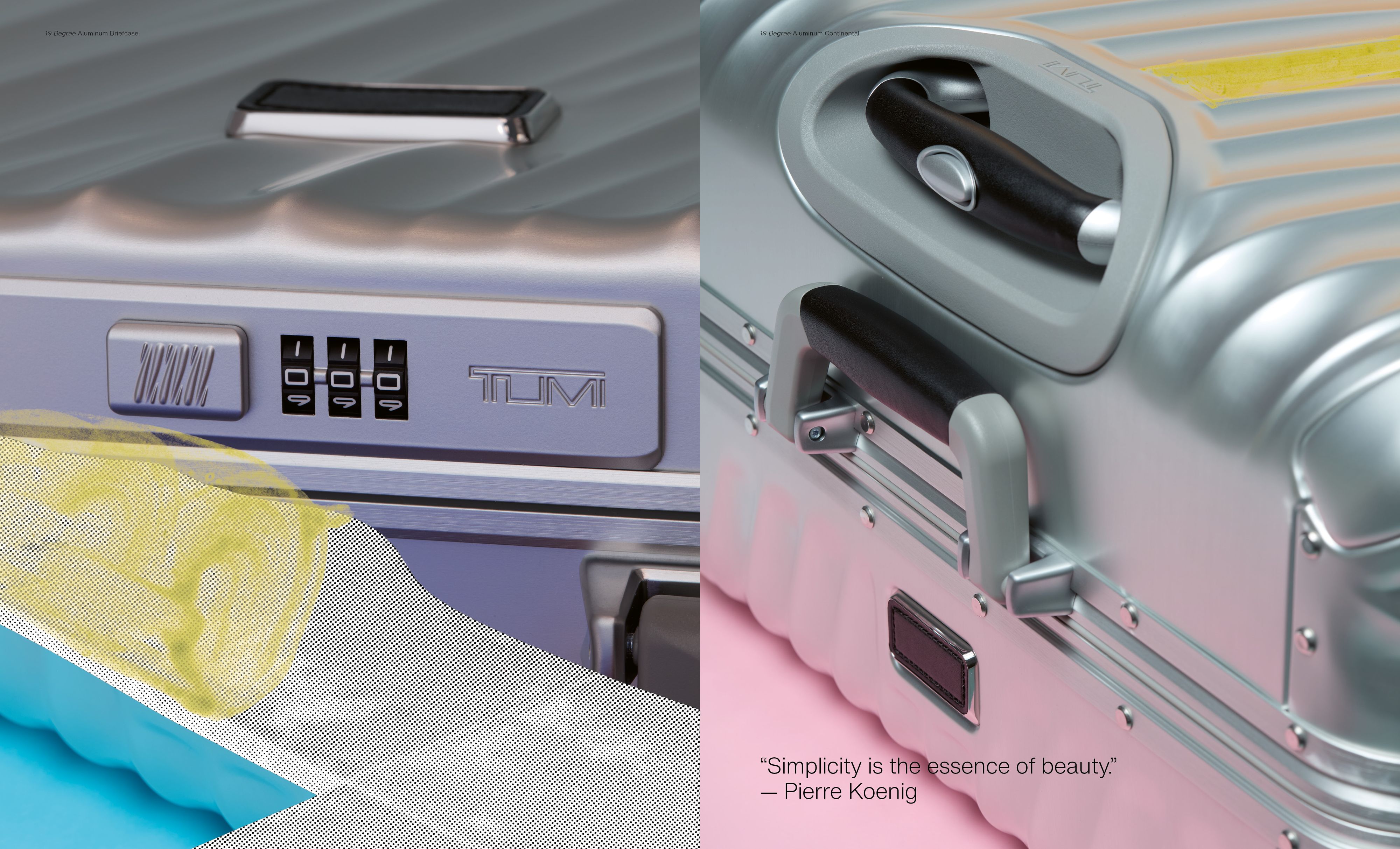
Collage featuring TUMI's 19 Degree Aluminum Briefcase (left) and 19 Degree Aluminum Continental Carry-On (right). Photography and artwork by Luke Libera Moore for PIN–UP.
Do you ever catch yourself becoming a jaded traveler?
Never. I never think, “Here we go again, I’m in Milan for design week.” It’s always about exploring — who I can share a meal with, which spots I want to revisit. This keeps every destination fresh.
Do you have travel rituals?
Simple rituals shaped by destination. I travel with the same kit — sunglasses, sketchbook, passport. Wherever I go, there are people I call first to share a meal. I used to buy new shoes before every trip but had to stop. [Laughs.]
What’s your luggage of choice?
My go-to carry-on is my 19 Degree aluminum, sometimes expandable depending on my shopping mood. For checked luggage, the 19 Degree Trunk — it sits in rooms like furniture and is super organized. I also travel with prototypes, testing how zippers zip, wheels roll, what happens if you overpack. Every trip is an opportunity for improvement.
What’s been the most radical evolution at TUMI since you started 22 years ago?
When I started, it was all two-wheel luggage. Then four-wheeled came out — I equate it to that evolution chart showing man walking upright. The brand transformed into more of a lifestyle brand. Initially it was all about function and durability. We discovered beauty and aesthetics are part of functionality. If a customer goes straight from the airport to a meeting, they should never feel embarrassed. They should walk into that boardroom confident, even after a 16-hour flight.
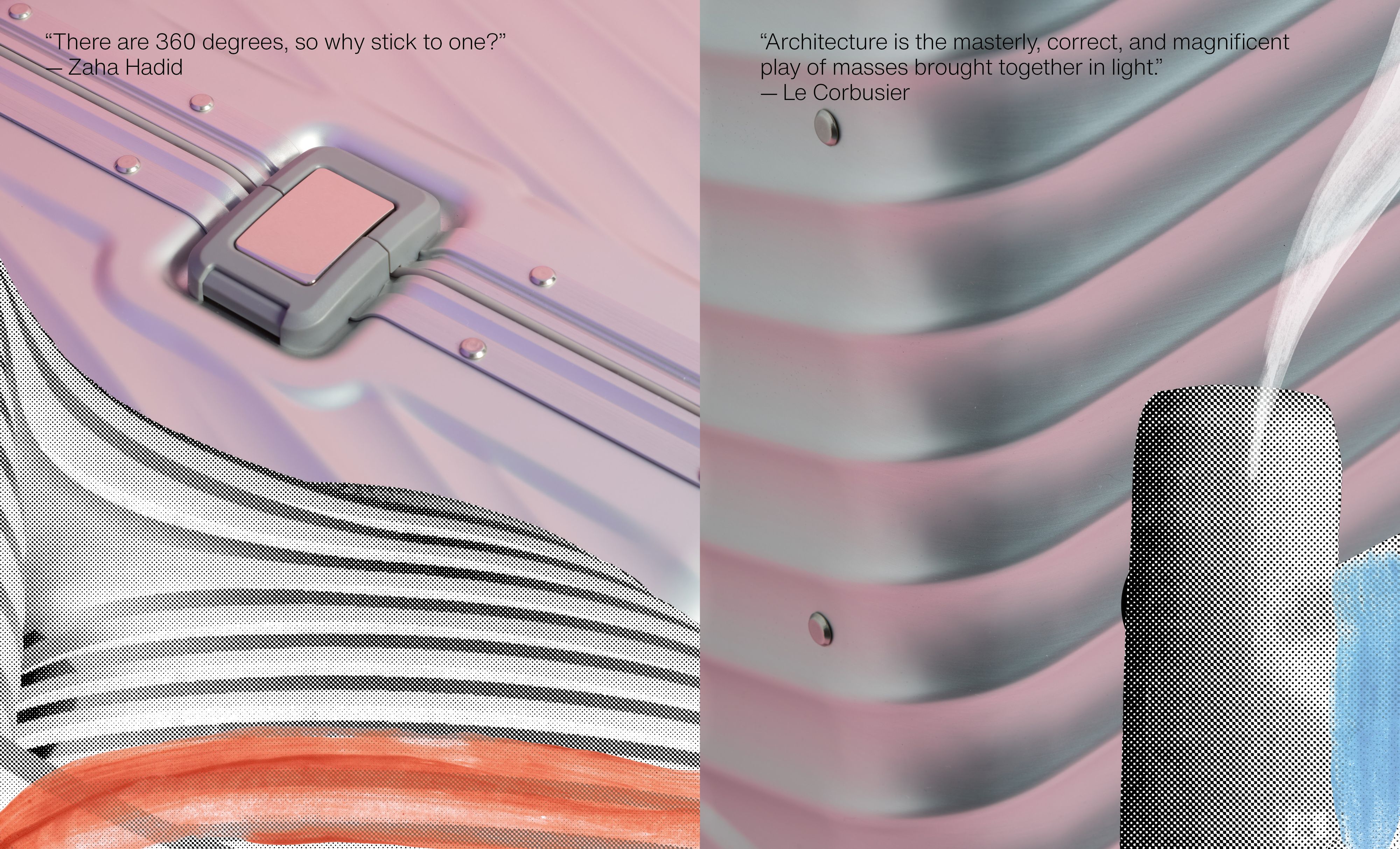
Collage featuring TUMI's 19 Degree Collection. Photography and artwork by Luke Libera Moore for PIN–UP.
TUMI turns 50 this year. How has travel and luggage evolved over five decades?
Travel used to be luxury in the 60s and 70s — formal, almost ceremonial. It became a commodity: people in pajamas focused on getting from A to B. Recently, there’s been a shift back toward experience. After COVID, travelers want the experience to feel personal, curated, reflective of who they are. Their luggage plays a huge role — it’s not just functional, it’s a statement, a companion, part of the journey.
Your thoughts on color and luggage?
When people close their eyes and think of TUMI, they think black luggage company. People don’t associate color with TUMI as much as they should. My bags always have neon green luggage tags. I have 19 Degree variants that never made the marketplace — none are black. You’ll see more color from TUMI. Our world is in technicolor, so why not express it? It doesn’t matter if I wear black all day — I’d rather carry bright bags.
How does architecture relate to what you do at TUMI?
It’s about scale, materials, and human experience. I grew up immersed in architecture — my father loved Gaudí, I was captivated by Zaha Hadid’s daring and Frank Gehry's unconventional materials. With 19 Degree, aluminum, leather, zinc, and titanium come together like small architecture. I often imagine scaling TUMI products up twenty thousand times — with tweaks, they could become interesting contemporary buildings.
What would you be designing if not luggage?
I’ve stayed at TUMI for two decades because it allows me to design almost anything — luggage, cars, pop-ups, furniture. I’d love to design the Olympic torch — such a unique object with symbolism. And now that you mentioned bias cuts, we may need to start a clothing line next.